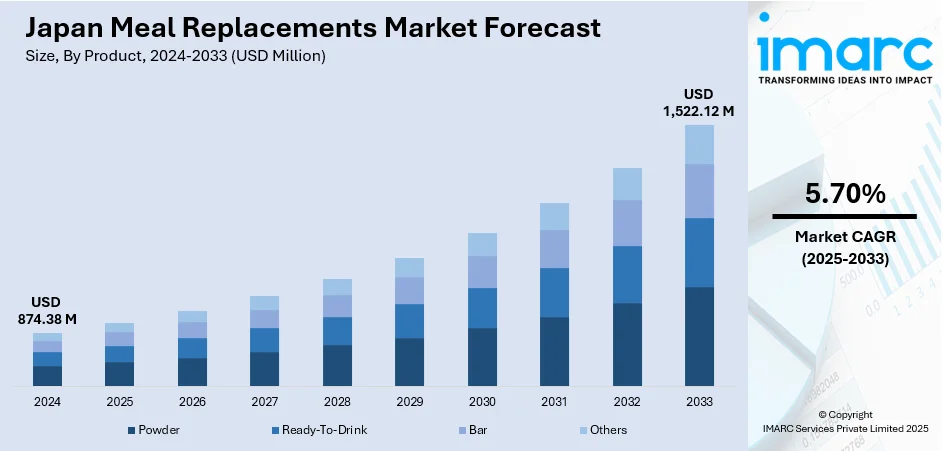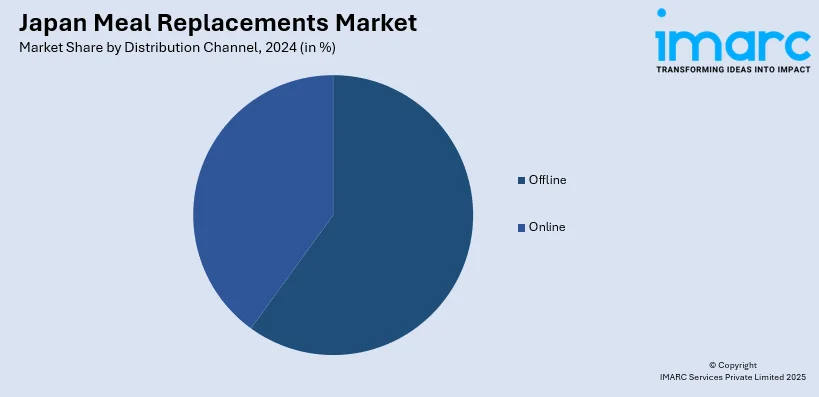
Japan Meal Replacements Market Size, Share, Trends and Forecast by Product, Distribution Channel, and Region, 2025-2033
Japan Meal Replacements Market Overview:
The Japan meal replacements market size reached USD 874.38 Million in 2024. Looking forward, IMARC Group expects the market to reach USD 1,522.12 Million by 2033, exhibiting a growth rate (CAGR) of 5.70% during 2025-2033. At present, the rising concern about health and wellness among the masses is contributing to the market growth. Moreover, continuous innovation and product diversification are propelling market growth. Apart from this, urban lifestyles, lengthy working hours, and hectic day-to-day activities are expanding the Japan meal replacements share.
|
Report Attribute
|
Key Statistics
|
|---|---|
|
Base Year
|
2024
|
|
Forecast Years
|
2025-2033
|
|
Historical Years
|
2019-2024
|
| Market Size in 2024 | USD 874.38 Million |
| Market Forecast in 2033 | USD 1,522.12 Million |
| Market Growth Rate 2025-2033 | 5.70% |
Japan Meal Replacements Market Trends:
Rising Health Awareness of Consumers
The rising concern about health and wellness is contributing to the market growth. Consumers are increasingly taking to meal replacement products to satisfy their nutritional requirements while leading busy lives. Individuals are looking for convenient, well-balanced, and healthier meal options compared to conventional foods. Since individuals are becoming more aware about how dietary intake affects their overall well-being, meal replacements are now being viewed as a convenient option for weight control, nutritional balance, and the maintenance of chronic health diseases. The Japanese market is specifically more conscious about the need for low-calorie, high-protein, and nutrient-rich products, which are now trending. Additionally, working professionals and individuals with not much time to spare on meal preparation are leaning towards meal replacements to satiate their energy requirements as well as fulfill nutritional standards. This move toward improved eating habits is driving the demand for meal replacements like protein bars and powders as a consistent form of diet throughout Japan. In 2025, Otsuka Pharmaceutical Co., Ltd. (Otsuka) launched its SOYJOY brand of whole-soy nutrition bars, "SOYJOY Black Sesame. The product is made with nutrient-packed sesame and has a low glycemic index to provide a unique sesame taste with a rich aroma.

To get more information on this market, Request Sample
Increasing Product Variety and Innovation
Continuous innovation and product diversification are propelling the Japanese meal replacements market growth. Companies are launching an array of meal replacement products, such as shakes, bars, powders, and ready-to-drink formats, which are formulated to suit various tastes and dietary needs. The diversification is fulfilling the growing need for vegan, gluten-free, and organic options. With a focus on convenience and health, brands are also adding functional ingredients like probiotics, fiber, and superfoods into their products. The relentless innovation of new flavors and specialized offerings, such as those for certain requirements like muscle recovery, weight management, or energy kick, is further driving consumer demand. As product ranges continue to progress, meal replacement options are gaining traction because young adults, sportspeople, and others are aiming to maximize their daily nutrients. In 2025, Japanese firm Nomura Dairy Products launched a probiotic carrot juice integrated with live Lactiplantibacillus plantarum 299v procured from Probi.
Increase in On-the-Go Lifestyle
Japan's high-speed lifestyle is driving the demand for meal replacements at a faster pace. Urban lifestyles, lengthy working hours, and hectic day-to-day activities are encouraging customers to seek more convenient meals. The demand for convenient, on-the-go nutritional alternatives is driving the development of meal replacements, as they provide fast and convenient solutions to address nutritional requirements without the lengthy preparation time associated with traditional meals. Consumers, especially office professionals, students, and tourists, are using meal replacements to ensure they are meeting their dietary requirements without disrupting their busy lifestyles. The incidence of one-person households in Japan is also driving the demand for ready-to-eat, portable food. According to the National Institute of Population and Social Security Research, single-person households are anticipated to make up 44.3% of all households in Japan by 2050.
Japan Meal Replacements Market Segmentation:
IMARC Group provides an analysis of the key trends in each segment of the market, along with forecasts at the country and regional levels for 2025-2033. Our report has categorized the market based on product and distribution channel.
Product Insights:
- Powder
- Ready-To-Drink
- Bar
- Others
The report has provided a detailed breakup and analysis of the market based on the product. This includes powder, ready-to-drink, bar, and others.
Distribution Channel Insights:

- Offline
- Hypermarkets and Supermarkets
- Convenience Stores
- Specialty Stores
- Others
- Online
A detailed breakup and analysis of the market based on the distribution channel have also been provided in the report. This includes offline (hypermarkets and supermarkets, convenience stores, specialty stores, and others) and online.
Regional Insights:
- Kanto Region
- Kansai/Kinki Region
- Central/ Chubu Region
- Kyushu-Okinawa Region
- Tohoku Region
- Chugoku Region
- Hokkaido Region
- Shikoku Region
The report has also provided a comprehensive analysis of all the major regional markets, which include Kanto Region, Kansai/Kinki Region, Central/ Chubu Region, Kyushu-Okinawa Region, Tohoku Region, Chugoku Region, Hokkaido Region, and Shikoku Region.
Competitive Landscape:
The market research report has also provided a comprehensive analysis of the competitive landscape. Competitive analysis such as market structure, key player positioning, top winning strategies, competitive dashboard, and company evaluation quadrant has been covered in the report. Also, detailed profiles of all major companies have been provided.
Japan Meal Replacements Market Report Coverage:
| Report Features | Details |
|---|---|
| Base Year of the Analysis | 2024 |
| Historical Period | 2019-2024 |
| Forecast Period | 2025-2033 |
| Units | Million USD |
| Scope of the Report |
Exploration of Historical Trends and Market Outlook, Industry Catalysts and Challenges, Segment-Wise Historical and Future Market Assessment:
|
| Products Covered | Powder, Ready-To-Drink, Bar, Others |
| Distribution Channels Covered |
|
| Regions Covered | Kanto Region, Kansai/Kinki Region, Central/ Chubu Region, Kyushu-Okinawa Region, Tohoku Region, Chugoku Region, Hokkaido Region, Shikoku Region |
| Customization Scope | 10% Free Customization |
| Post-Sale Analyst Support | 10-12 Weeks |
| Delivery Format | PDF and Excel through Email (We can also provide the editable version of the report in PPT/Word format on special request) |
Key Questions Answered in This Report:
- How has the Japan meal replacements market performed so far and how will it perform in the coming years?
- What is the breakup of the Japan meal replacements market on the basis of product?
- What is the breakup of the Japan meal replacements market on the basis of distribution channel?
- What is the breakup of the Japan meal replacements market on the basis of region?
- What are the various stages in the value chain of the Japan meal replacements market?
- What are the key driving factors and challenges in the Japan meal replacements market?
- What is the structure of the Japan meal replacements market and who are the key players?
- What is the degree of competition in the Japan meal replacements market?
Key Benefits for Stakeholders:
- IMARC’s industry report offers a comprehensive quantitative analysis of various market segments, historical and current market trends, market forecasts, and dynamics of the Japan meal replacements market from 2019-2033.
- The research report provides the latest information on the market drivers, challenges, and opportunities in the Japan meal replacements market.
- Porter's five forces analysis assist stakeholders in assessing the impact of new entrants, competitive rivalry, supplier power, buyer power, and the threat of substitution. It helps stakeholders to analyze the level of competition within the Japan meal replacements industry and its attractiveness.
- Competitive landscape allows stakeholders to understand their competitive environment and provides an insight into the current positions of key players in the market.
Need more help?
- Speak to our experienced analysts for insights on the current market scenarios.
- Include additional segments and countries to customize the report as per your requirement.
- Gain an unparalleled competitive advantage in your domain by understanding how to utilize the report and positively impacting your operations and revenue.
- For further assistance, please connect with our analysts.
 Request Customization
Request Customization
 Speak to an Analyst
Speak to an Analyst
 Request Brochure
Request Brochure
 Inquire Before Buying
Inquire Before Buying




.webp)




.webp)












